Roman Opel Swagetti
with Ray Moon (LosDQ)
Radius Festival, Maastricht, NL.
2025
with Ray Moon (LosDQ)
Radius Festival, Maastricht, NL.
2025
During recent 3D scans conducted by
KNA archaeologists Ba at GEONIUS on the Radium site in Maastricht,
traces were found indicating a previously unknown practice within the
late Roman presence in the region: the intentional filling of carts,
cistae (containers), and even public structures with what, after
forensic analysis, was identified as starch; wheat pasta (durum) –
specifically spaghetti-like structures.
This discovery has sparked an artistic and speculative inquiry into the semantics, tactility, and political significance of pasta in everyday life. Among the Romans, heavily influenced by the Noodellians, spaghetti held the same symbolic place as rice: bottom left.
Further fieldwork on section C-12 of the site revealed sediment remains with a strikingly linear pattern. After rehydration experiments and cross-disciplinary collaboration, it was confirmed with 87% certainty that the material was cooked spaghetti (Al Dente).
Professor John B. Drusters and researcher Hannah Doos.
Due to the rapid developments of Al Dente, progress accelerates significantly. (11 minutes)
Drusters: “We therefore propose approaching this find as a form of ‘boppen’. It's about intimidation and dragging along. The Romans keep pushing it further back, and the stalling research can be seen as a metaphor for the slipping of control, but also as a tool to reclaim that very control. Just look at a photograph. And make sure these practices are re-embodied in a contemporary context of chaos, abundance, and collective memory.”
Doos: “Thanks to a misdirected mailbox, LosDQ was able to lift the spaghetti tip (the so-called bops) of this veil at today’s celebration. The Noodellians quickly surrendered and started cheering in a corner.”
(Lanakerveld. K.I. 3564-09)
Note: They too were children in a time of great heroes in small buckets. Their laughter remains etched on their faces. Hub’s mother was always startled when John had cooked again. Hannah would always pop by to say hi.
The Moonens – LosDQ 2025
This discovery has sparked an artistic and speculative inquiry into the semantics, tactility, and political significance of pasta in everyday life. Among the Romans, heavily influenced by the Noodellians, spaghetti held the same symbolic place as rice: bottom left.
Further fieldwork on section C-12 of the site revealed sediment remains with a strikingly linear pattern. After rehydration experiments and cross-disciplinary collaboration, it was confirmed with 87% certainty that the material was cooked spaghetti (Al Dente).
Professor John B. Drusters and researcher Hannah Doos.
Due to the rapid developments of Al Dente, progress accelerates significantly. (11 minutes)
Drusters: “We therefore propose approaching this find as a form of ‘boppen’. It's about intimidation and dragging along. The Romans keep pushing it further back, and the stalling research can be seen as a metaphor for the slipping of control, but also as a tool to reclaim that very control. Just look at a photograph. And make sure these practices are re-embodied in a contemporary context of chaos, abundance, and collective memory.”
Doos: “Thanks to a misdirected mailbox, LosDQ was able to lift the spaghetti tip (the so-called bops) of this veil at today’s celebration. The Noodellians quickly surrendered and started cheering in a corner.”
(Lanakerveld. K.I. 3564-09)
Note: They too were children in a time of great heroes in small buckets. Their laughter remains etched on their faces. Hub’s mother was always startled when John had cooked again. Hannah would always pop by to say hi.
The Moonens – LosDQ 2025

